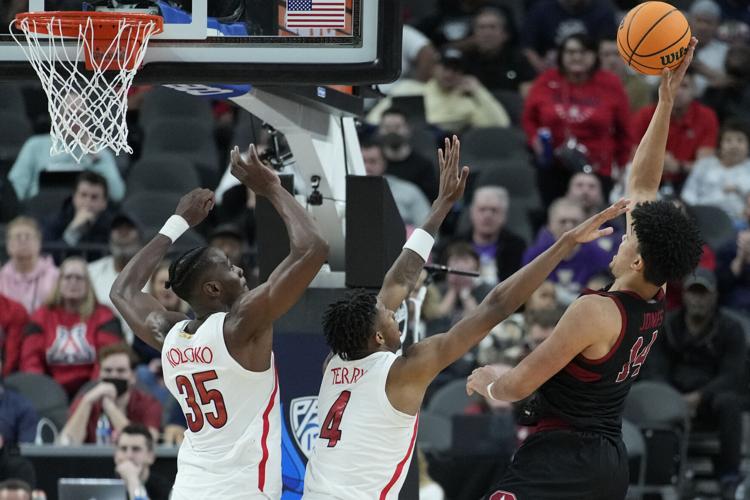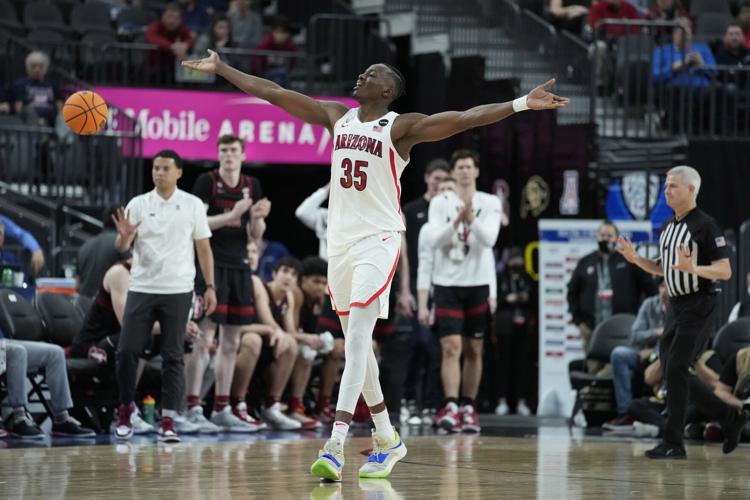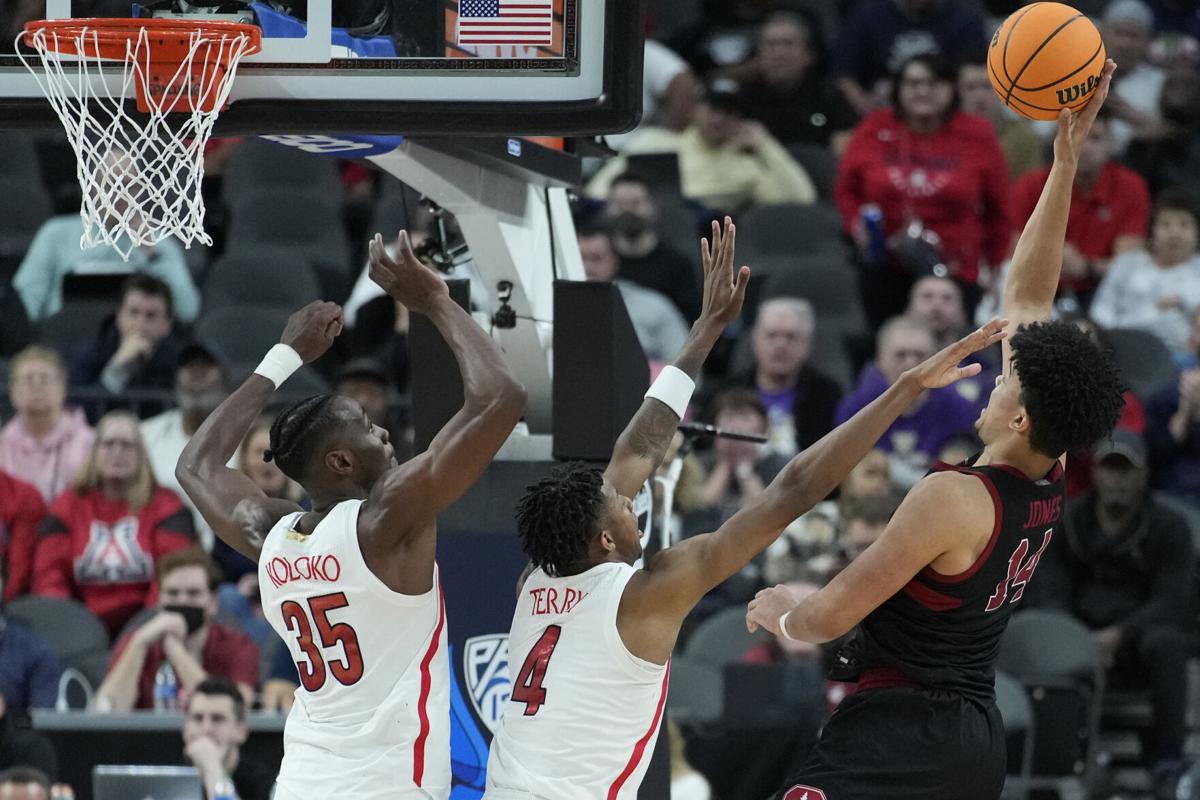LAS VEGAS — Each time Stanford seemed to need a basket Thursday, Cardinal assistant coach Adam Cohen quickly used code, relaying strategy to the Pac-12’s ninth-seeded team with a few simple words on a whiteboard:
Spear.
Chipper.
Floppy.
Tesla.
Get it!
Arizona never truly cracked the code. Almost everything Stanford tried worked. And almost every Wildcat fan at T-Mobile Arena summoned grim memories of similar, everything-that-could-go-wrong-did-go-wrong games in March.
Like Wisconsin’s Frank Kaminsky playing a perfect game to bury the Wildcats at the Elite Eight. Or Wichita State’s Fred VanVleet looking every bit the future NBA All-Star he would become, igniting Arizona’s first-round exit.
For 38 minutes Thursday, the Wildcats were speared, flopped and chipped and a few other things, until finally, in the last few possessions, Arizona played like the nation’s No. 2 team and Stanford didn’t “get it.”
“To overcome a performance like that in a game like this is pretty special,” Arizona coach Tommy Lloyd said after an exercise in survival, an 84-80 victory. “Their whole team rose to the occasion.”
On Thursday, Stanford junior forward Spencer Jones was both Kaminsky and VanVleet. He scored a career-best 28 points. He exhausted Arizona’s defensive adjustments, scoring first on Bennedict Mathurin, next on Pelle Larsson and finally on Dalen Terry.
It was hauntingly similar to Tennessee forward John Fulkerson scoring a season-high 24 against the Wildcats in December. Somehow, Jones was not among the 15 Pac-12 players listed on the All-Pac-12 teams a few days ago — he was an honorable mention selection — but on Thursday he was “Mr. Big.” The instant the clock expired, Mathurin, Terry, Justin Kier and Christian Koloko jogged to Jones, giving him bro-hugs and knuckle bumps, as if to say: “You’re the man.”

Arizona’s Christian Koloko celebrates late in Thursday’s four-point win over Stanford.
For Arizona, it was an escape like few in March. Usually a “You’re the man” performance sends you home. But not this time for one reason: Koloko also played the best game of his career, with an unprecedented high of 24 points, with a best-ever shooting game, 10 for 12.
Koloko not only played well, he played smart. He stayed deep in the paint and didn’t force shots in traffic or step outside to find some space. “I took what they gave me,’’ he said, plainly.
A lot of basketball analysts will disagree on the difficulty of Arizona’s harrowing victory and what it might mean. Kenpom.com, for example, dropped Arizona from No. 2 to No. 4 in its metric rankings within a half-hour of the game’s finish, elevating Baylor and Kentucky above the Wildcats. Others might argue that it was good for the Wildcats to play a close game in a month that overflows with close games.
It was just the fourth time in 32 games that the Wildcats experienced anxiety in the final two or three minutes. It lost at Tennessee 77-73, beat Wichita State 82-78 in overtime, held on to beat Oregon 84-81 and persevered to win at Illinois, 83-79.
Every other game, win or lose, had nothing like the drama of Thursday’s win over the Cardinal.
Lloyd, for one, didn’t seem to mind the challenge. Rather than walk into a postgame press conference with a gloomy expression — we saw enough of that negative-approach the last 12 years — he explained the defensive breakdowns against Jones and Harrison Ingram by saying “we made a mistake here and there on our defensive assignments” and instead focused on the positive.
“Somebody told me that if we won today, I’d want to see the place (T-Mobile Arena) tomorrow night,” he said.
T-Mobile was mostly subdued for the first 30 minutes Thursday and then, after Stanford took a 61-60 lead, about 5,000 Wildcats fans got the message — loud and clear, with an emphasis on loud.
Stanford coach Jerrod Haase’s game plan was to be unafraid, attack Arizona in the paint — which almost no one has done all season — and it worked so well that it made you wonder how the Cardinal are 16-16. Stanford had the look and confidence of a 26-6 team.
Gone was the Stanford team that ranked a ridiculously low 335th in the NCAA in turnovers and No. 295 in 2-point shooting percentage. Instead, Stanford committed just 12 turnovers and shot 55% from 2-point range.
“It was really cool to see the guys execute the game plan to the best of their ability,” said Haase. Wisely, he gave Jones the green light.
Said Jones: “Coach told me to take as many shots as I felt comfortable with. I had to be as aggressive as I could.”
Cardinal fans must be asking themselves where that ambition has been all season. There is no good answer.
Arizona didn’t have all the answers Thursday, but it didn’t need to. That’s how it works now. It’s survive and advance — learn what you need to do to improve — rather than stock up style points.
In the first-round of the 2014 Pac-12 Tournament the Wildcats humbled a 21-win Utah team 71-39 and followed by beating a 23-win Colorado team 63-43. They were 30-3, sailing, almost carefree, almost unchallenged.
And then they lost to unranked UCLA in the tournament finals.
Before Lloyd left the media Q&A Thursday, he did not say, “If we play like this tomorrow, we’ll be going home.” Instead, he just said it will be “nice to be playing tomorrow.”






